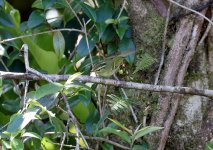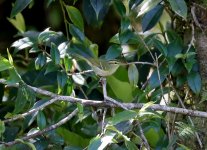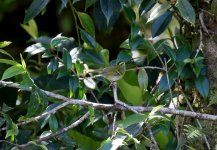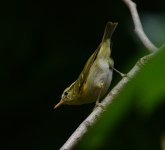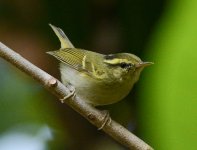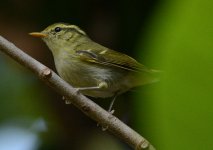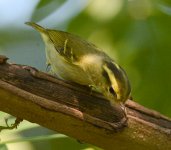-
Welcome to BirdForum, the internet's largest birding community with thousands of members from all over the world. The forums are dedicated to wild birds, birding, binoculars and equipment and all that goes with it.
Please register for an account to take part in the discussions in the forum, post your pictures in the gallery and more.
You are using an out of date browser. It may not display this or other websites correctly.
You should upgrade or use an alternative browser.
You should upgrade or use an alternative browser.
Warbler from Vietnam (1 Viewer)
- Thread starter tony.saw
- Start date
More options
Who Replied?This looks like either Blyth's or Claudia's Leaf Warbler - combination of double wing-bar, rather smudgy crown stripe becoming stronger and whiter at the rear, black eye stripe, plain lime-green wing. For me, it doesn't have the yellow tones of Kloss's, which would be the main confusion species. See this exhaustive study by Ayuwat (Davison's, closely related to Kloss's, doesn't occur in Vietnam).
https://ayuwat.wordpress.com/2013/10/13/blythsclaudiasdavisons-part-1/
https://ayuwat.wordpress.com/2013/10/14/blythsclaudiasdavisons-part-2/
https://ayuwat.wordpress.com/2013/10/25/blythsclaudiasdavisons-part-3/
As Ayuwat points out, the two species are difficult to separate on plumage features alone, unless you get a good clear view of the undertail pattern. Behaviour is a better way to separate them - did this bird display the Nuthatch-like feeding behaviour of Claudia's shown in the second blog page? It's showing a Claudia's-like pose in the 2nd image, but Blyth's will also hold a pose like this, if not for very long. Your bird also seems to be flicking one wing, which is supposed to be more of Claudia's, but this is not a conclusive feature.
I don't know the location, but I see it's Central Annam. This would be some way from the isolated population of Blyth's (form ticehursti around the Lang Bian plateau, so unless it's an extension, it would be the assamensis form of Blyth's, which winters in Vietnam, or Claudia's, which is supposed to be an autumn migrant in the north of the country, but could conceivably winter further south? What's the altitude of this location?
Do you have any more images, even poor ones? A view of the undertail would help.
https://ayuwat.wordpress.com/2013/10/13/blythsclaudiasdavisons-part-1/
https://ayuwat.wordpress.com/2013/10/14/blythsclaudiasdavisons-part-2/
https://ayuwat.wordpress.com/2013/10/25/blythsclaudiasdavisons-part-3/
As Ayuwat points out, the two species are difficult to separate on plumage features alone, unless you get a good clear view of the undertail pattern. Behaviour is a better way to separate them - did this bird display the Nuthatch-like feeding behaviour of Claudia's shown in the second blog page? It's showing a Claudia's-like pose in the 2nd image, but Blyth's will also hold a pose like this, if not for very long. Your bird also seems to be flicking one wing, which is supposed to be more of Claudia's, but this is not a conclusive feature.
I don't know the location, but I see it's Central Annam. This would be some way from the isolated population of Blyth's (form ticehursti around the Lang Bian plateau, so unless it's an extension, it would be the assamensis form of Blyth's, which winters in Vietnam, or Claudia's, which is supposed to be an autumn migrant in the north of the country, but could conceivably winter further south? What's the altitude of this location?
Do you have any more images, even poor ones? A view of the undertail would help.
johnallcock
Well-known member
I think that Goodson's/Hartert's LW also warrants consideration in Vietnam. This is the commonest species from this complex wintering in south China.
Sorry, I don't have any further advice on which this bird is - it's a group that needs better understanding of ID features!
Sorry, I don't have any further advice on which this bird is - it's a group that needs better understanding of ID features!
I think that Goodson's/Hartert's LW also warrants consideration in Vietnam. This is the commonest species from this complex wintering in south China.
Sorry, I don't have any further advice on which this bird is - it's a group that needs better understanding of ID features!
John, Ayuwat suggested Hartert's for a bird I saw at Hoi An in Dec 15, but the images I studied showed strong yellow tones, which didn't seem right for the bird I saw. It seems too yellow for this bird too. I know nothing about Goodson's. HBW suggests only that fokiensis might reach Vietnam.
johnallcock
Well-known member
John, Ayuwat suggested Hartert's for a bird I saw at Hoi An in Dec 15, but the images I studied showed strong yellow tones, which didn't seem right for the bird I saw. It seems too yellow for this bird too. I know nothing about Goodson's. HBW suggests only that fokiensis might reach Vietnam.
Sorry, perhaps some ambiguity and confusion from my post. Hartert's and Goodson's are both names for the same species, Phylloscopus goodsoni. There are two subspecies:
- nominate goodsoni, which is usually bright yellow below, sometimes approaching the colours of Sulphur-breasted Warbler (http://orientalbirdimages.org/search.php?Bird_Image_ID=69213&Bird_ID=2916&Bird_Family_ID=&Location=)
- fokiensis, which is whiter below (http://orientalbirdimages.org/search.php?Bird_Image_ID=104351&Bird_ID=2916&Bird_Family_ID=&Location=)
The problem is that, as far as I know, there seems to be no confirmed features to definitively separate fokiensis from claudiae (and possibly from reguloides subspecies) except song and DNA. For example, in Hong Kong all white-bellied birds are treated as fokiensis/claudiae, neither of which is confirmed in HK, although potentially both occur.
The subject bird in this thread is not nominate goodsoni, but I'm not sure that fokiensis can be conclusively ruled out, and the yellowish wash to the supercilium may actually favour that taxon over claudiae.
Bryon Wright
Well-known member
Hi all,
John, hope I am correct in saying that the Goodson's, in Kowloon Park, have a much brighter yellow coronal stripe!
John, hope I am correct in saying that the Goodson's, in Kowloon Park, have a much brighter yellow coronal stripe!
johnallcock
Well-known member
Hi all,
John, hope I am correct in saying that the Goodson's, in Kowloon Park, have a much brighter yellow coronal stripe!
Perhaps slightly yellower on a goodsoni (http://orientalbirdimages.org/search.php?Bird_Image_ID=69211&Bird_ID=2916&Bird_Family_ID=&Location=).
But it would be an unusual record in Kowloon Park - they're rare away from the forest!
Sorry, perhaps some ambiguity and confusion from my post. Hartert's and Goodson's are both names for the same species, Phylloscopus goodsoni. There are two subspecies:
- nominate goodsoni, which is usually bright yellow below, sometimes approaching the colours of Sulphur-breasted Warbler (http://orientalbirdimages.org/search.php?Bird_Image_ID=69213&Bird_ID=2916&Bird_Family_ID=&Location=)
- fokiensis, which is whiter below (http://orientalbirdimages.org/search.php?Bird_Image_ID=104351&Bird_ID=2916&Bird_Family_ID=&Location=)
The problem is that, as far as I know, there seems to be no confirmed features to definitively separate fokiensis from claudiae (and possibly from reguloides subspecies) except song and DNA. For example, in Hong Kong all white-bellied birds are treated as fokiensis/claudiae, neither of which is confirmed in HK, although potentially both occur.
The subject bird in this thread is not nominate goodsoni, but I'm not sure that fokiensis can be conclusively ruled out, and the yellowish wash to the supercilium may actually favour that taxon over claudiae.
Thanks for this, John. With you now. This of course muddies the waters still further - the Hoi An bird I saw could have been one of three species then - assamensis Blyth's, Claudia's or fokiensis Goodson's. :eek!:
johnallcock
Well-known member
Thanks for this, John. With you now. This of course muddies the waters still further - the Hoi An bird I saw could have been one of three species then - assamensis Blyth's, Claudia's or fokiensis Goodson's. :eek!:
Yep, that sounds about right for a Phylloscopus.
(BTW, did you rule out emeiensis?
gandytron
Well-known member
Bryon Wright
Well-known member
Warbler Id.
Hi Dave, Tony and Andy
Dave, a great set of pictures. Was it an easy Id. process because they are either up in the canopy or at arm's length? Also from memory expected a clearly defined and brighter coronal stripe like some views suggest.
Dave's photo #2 the seemingly severed finger in your photo? It is not just a claw folded under itself. Also the apparent horn and orange colours dividing the culmen ridge. Never noticed a bi-coloured upper mandible like this on any warbler species before. Can anyone else see this?
Never attempted to define any Blyth's except in Thailand and China. Suggest Dave's bird illustrates a lowland, winterer and Tony has the upland resident. Studied both the resident and migratory races on Suthep a long time ago even have the vocals somewhere. What names do these older Blyth's/White-tailed groupings get from the Thai birders now? Is it still klossi for the resident race?
Apart from the peculiarities I have mentioned these birds seem to have a miniscule flycatcher like hook to the triangular beak, even more so than eastern crowned warblers. Their claws are always paler as well and the legs invariably lack the brightness of other warblers.
Hi Dave, Tony and Andy
Dave, a great set of pictures. Was it an easy Id. process because they are either up in the canopy or at arm's length? Also from memory expected a clearly defined and brighter coronal stripe like some views suggest.
Dave's photo #2 the seemingly severed finger in your photo? It is not just a claw folded under itself. Also the apparent horn and orange colours dividing the culmen ridge. Never noticed a bi-coloured upper mandible like this on any warbler species before. Can anyone else see this?
Never attempted to define any Blyth's except in Thailand and China. Suggest Dave's bird illustrates a lowland, winterer and Tony has the upland resident. Studied both the resident and migratory races on Suthep a long time ago even have the vocals somewhere. What names do these older Blyth's/White-tailed groupings get from the Thai birders now? Is it still klossi for the resident race?
Apart from the peculiarities I have mentioned these birds seem to have a miniscule flycatcher like hook to the triangular beak, even more so than eastern crowned warblers. Their claws are always paler as well and the legs invariably lack the brightness of other warblers.
gandytron
Well-known member
Bryon,
I still need to write it up (oops!), but the ID was not entirely straightforward, mostly because myself and other observers had limited/zero experience of Hartert's. Ultimately it was identified by sending photos to Paul Leader who quickly confirmed our suspicions that it was Hartert's.
It was found by a photographer and the single image that was posted originally online indicated extremely yellow underparts, but when I relocated it, it became apparent that this was photographic artifact, though the underparts did show a lot of yellow on the belly and vent, and olive tones on the breast.
The bird was actually missing a toe on the right foot.
In Thailand Kloss's Leaf Warbler seems to be pretty restricted (recent interest in one or two birds well photgraphed Khao Yai) whilst the birds in the western forest complex and the north are Davison's.
Ayuwat's extensive blog posts mentioned by Andy in post #2 above are a very useful reference.
Best wishes,
Dave
I still need to write it up (oops!), but the ID was not entirely straightforward, mostly because myself and other observers had limited/zero experience of Hartert's. Ultimately it was identified by sending photos to Paul Leader who quickly confirmed our suspicions that it was Hartert's.
It was found by a photographer and the single image that was posted originally online indicated extremely yellow underparts, but when I relocated it, it became apparent that this was photographic artifact, though the underparts did show a lot of yellow on the belly and vent, and olive tones on the breast.
The bird was actually missing a toe on the right foot.
In Thailand Kloss's Leaf Warbler seems to be pretty restricted (recent interest in one or two birds well photgraphed Khao Yai) whilst the birds in the western forest complex and the north are Davison's.
Ayuwat's extensive blog posts mentioned by Andy in post #2 above are a very useful reference.
Best wishes,
Dave
Users who are viewing this thread
Total: 2 (members: 0, guests: 2)




